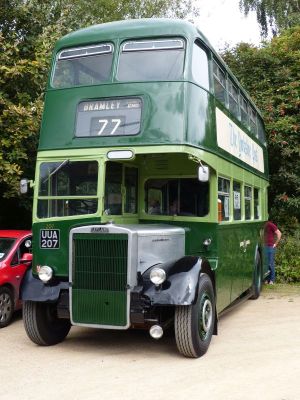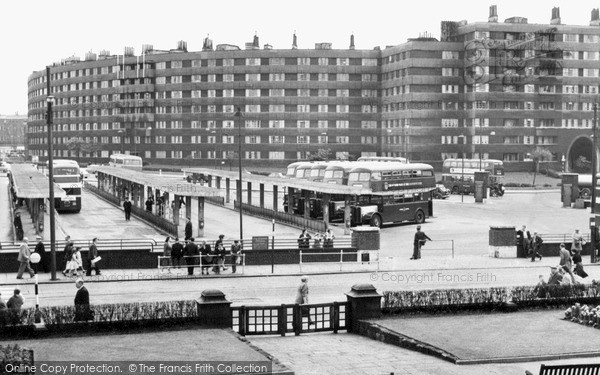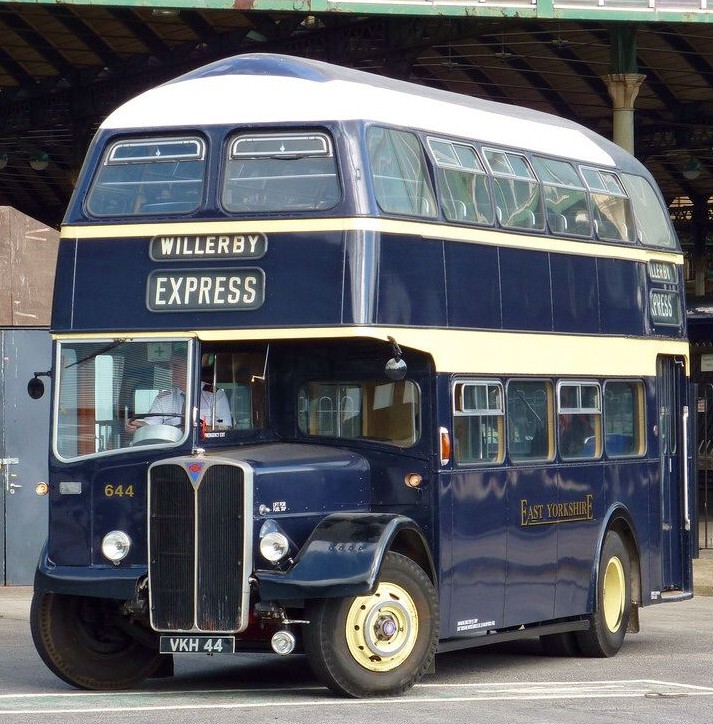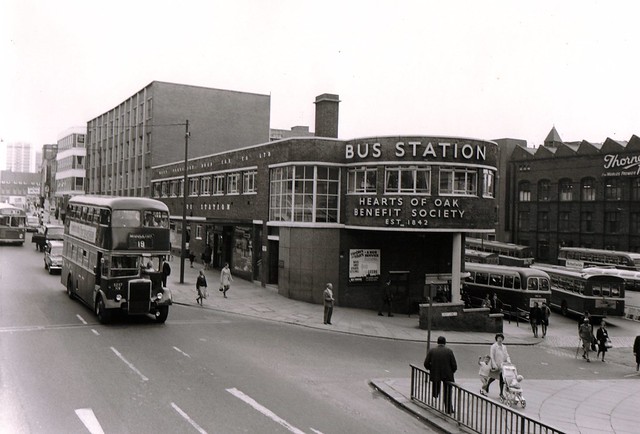|
All Aboard -Leeds Buses by DavidMcKie &
recollections by John Swash
|
|
Extract from Great British Bus Journeys, by David
McKie, published by Atlantic Books 2006.
When David McKie
and his family moved to Leeds as wartime refugees, it was the city's
old green buses that came to mean home to him. Here, in an extract
from his book, he explains why the humble bus is such a cornerstone
of British culture.
|
Bradford's were
blue. Sheffield's were cream and blue. Halifax's were green and orange,
as if they had somehow escaped from Glasgow. In Leeds, ours were green;
a slightly dour, urban green. Southdown's, on the south coast, were
a more meadow-like shade of green; Bournemouth's, or so it was declared
by those who had holidayed there, were an exotic buttercup yellow.
And London's, as everyone knows, were red.
Some people shun service buses: they don't like having strangers jammed
up against them. The normally gregarious Conservative politician Steven
Norris once declared his distaste for using the bus because of the
kind of people he found himself sitting next to. For others, the common
service bus is a kind of ambulance of failures. That champion of the
great car economy, Margaret Thatcher, is often quoted as saying that
any man over 26 travelling by bus must have lost out in life. One
can't help feeling, though, that it might have done Margaret Thatcher
good to travel just now and then, in heavy disguise of course, on
a humble service bus alongside the people over whom she presided.
Had she so demeaned herself at the height of her power, to catch the
bus from Grantham to Sleaford, for instance, she might have heard
conversations cautioning her against the fatal poll tax or her apparent
assumption that people work best when they feel insecure. |

Leyland half-cab bus in green 1960's LCT livery
|
| In Leeds, where I grew up,
the corporation buses were green by order of the municipality after
the war. In wartime - not in order to confuse the Germans, as people
sometimes supposed, but because the old paints were no longer available
- both buses and trams had turned a dodgy khaki. With peace, the trams
re-emerged as red and the buses as green. The Conservatives, turned
out by Labour in the council elections of 1945, protested that this
was political manipulation. If the trams were to be dressed in socialist
red, then the buses, they insisted, must be painted Conservative blue.
But the chairman of the transport committee of Leeds council, Alderman
Rafferty, said this was stuff and nonsense. The choice of red for
the trams was pragmatic. Leeds was buying London trams as London dispensed
with them, and London's trams were red. "Dozens of people have
written in praise of the colour of the red tram in Leeds," the
alderman robustly claimed. |
|
On the
eastern edge of the city centre, beyond Kirkgate market, in the
shadow of Quarry Hill flats, stood the city bus station. Sometimes
claimed in Leeds to have been the biggest such complex in Europe,
erected by a pioneering housing department in days of huge municipal
pride and endeavour, the flats were demolished in 1978. We had almost
lived there.
As refugees from Hitler's V-bombs in London, one of which killed
my father in June 1944, we had lived with an aunt in Whitkirk, a
suburb of Leeds, until my uncle returned from the war and wanted
us out. My mother, brother and I were rescued by the Leeds housing
department.
|

Leeds Central bus station located near Kirgate market and Quarry Hill
flats in 1954 |
| They
offered us a flat in the Quarry Hill complex but, desperate though
our predicament was, my mother rejected its lowly ceilings as too
dark and claustrophobic. Instead they found us a house that belonged
to a man who had been imprisoned in Singapore. It was on the hill
up from Chapel Allerton into Moortown, quite an expensive territory.
You got off the number 2 Circular tram at the Kingsway cinema, which
later became a synagogue, known to us lads as the cinemagogue. Even
now I cannot look at it without recalling the matchless exhilaration
of the night when the wartime ban on neon lights was at last rescinded
and the name of the Kingsway glowed in the evening sky, and throughout
the city the streets were full of people gazing in rapture at a lightscape
now taken for granted. |
| It took a long while for the
old Leeds to die and for the new super-Leeds - that transformation
of the heart of the city from grim and intensely Yorkshire to glittering
celebration of big European money - to replace it. One part of this
new enrichment, occupying one end of the old Quarry Hill site, is
the hugely successful West Yorkshire Playhouse. At the great plate-glass
windows of its cafe-restaurant you can sit with your cappuccino or
americano (products quite unknown in my childhood) and watch today's
buses wheeling in and out of the bus station, carrying passengers
to destinations not dreamed of in Alderman Rafferty's time.There is
one that serves both Odsal Top and Stanningley Bottom. In summer,
you can even catch a bus that runs directly to Blubberhouses. In territory
once dedicated almost exclusively to serving the city suburbs, there
are buses to places all over the county and well beyond. There's a
Pink line and an Indigo line (though sadly their buses are not painted
pink or indigo), and Coastliners to Whitby and Scarborough and Flamingoland.
Here are multicoloured Black Prince buses, each one, it seems, a different
concoction of shades from the Black Prince before it, a blue and white
Keighley and District with a big red K making it look like an advert
for breakfast cereal, and a red and cream Harrogate and District still
decorated with the legend "Bus Operator of the Year 2002".
|
|
At the bus station I overhear one bus
driver relating to a colleague an incident with another bus which
tried to steal a space he was heading into. He lost. "But he,"
he says, as if in mitigation, "It were an Olympian." An
Olympian? Zeus, in a bus station? But an Olympian, I've discovered,
having bought a magazine called Buses from the station bookstall,
is a kind of large and superior bus. To your true bus devotee, and
as anyone who has been to their rallies will know, they are many.
The buses that swirl around Leeds bus station are not just Arrivas
or Firsts but Leylands, AECs, Guys and Dennises, Titans and Olympians,
Atlanteans and Lodekkas. Some of these buses carry ads on their
sides, offering, for no more than it costs to get you to London
or Edinburgh, trips to destinations that many in Leeds would never
have heard of in Alderman Rafferty's heyday: Venice, £21;
Malaga, £23.
Meanwhile, the suburban buses mostly run from the city centre, sparing
shoppers the trail though Kirkgate market (now only half the size
it used to be, since a disastrous fire). The services have been
"rationalised" since the first wild days of deregulation
in 1986, which means in effect that the big operators - Arriva and
First - have eliminated or gobbled up smaller ones. Even plucky
Black Prince, the last Leeds independent operator of commercial
services, was breathing its last in the spring of 2005 as the mighty
maw of First opened a little further to swallow it.
|
| Recollections of Leeds City Transport
Buses by John Swash |
|
One of the advantages
of growing up in a city like Leeds was the availability of a reliable
and frequent public transport system. By the time I attended WLBHS,
trams had been phased out, and public transport was provided by
the numerous Leeds City Transport (LCT) buses in their distinctive
dark green livery.
|
 |
|
The school had a broad catchment area,
so that many pupils depended on the bus to get to school. I never
saw pupils being dropped off outside the school by car in those
days. The majority walked or cycled to school or caught the bus.
A few from Bramley caught the train to Armley Canal Road Station.
I used to catch the bus from Bramley Town End, but in good weather
would often walk to save the fare.
|
|
Apart from everyday travel, we could
explore the city for pleasure and entertainment for the cost of
a 3d bus fare. On hot summer days, my friends in Bramley and I would
think nothing of catching a bus across the city to visit Roundhay
Park, which had the only open-air pool, or Lido, in Leeds. We were
not restricted to cinemas within walking distance of home; we could
see the latest films at city centre cinemas. LCT used to operate
special buses to take us to events such as air displays at Church
Fenton or sporting events at Roundhay Park and Headingley. There
was also an "intercity" service to Bradford.
The main hub for the green LCT buses was the central bus station
at New York Street, near Quarry Hill Flats. Besides the multitude
of green LCT buses, a few "exotic" bus services ran from
there in the dark blue and cream livery of East Yorks, or the cream
and blue livery of South Yorks.
|
|

An East Yorkshire bus with
the peculiar "zeppelin" roof shape designed to pass through
Beverly Bar.
|
|

The West Yorkshire "red"
bus station on Vicar Lane provided out of town services to the Yorkshire
Dales , West and North Yorkshire.
|
|
Most of the "long-haul"
services from Leeds were operated by the West Yorkshire Road Car
Company , recognisable by their distinctive post office red livery.
These services ran from their own West Yorkshire bus station in
Vicar Lane to various destinations, including Wetherby, Otley, Ilkley,
York, Knaresborough, Ingleton, in the Yorkshire Dales. My first
visit to the Lake District was on one of these buses. Many of these
out-of-town buses were single deck or low-deck double-deckers (Lodekkas),
allowing them to pass under low bridges. As a result, upper-deck
passengers had to sit on four-seater benches with an aisle on the
right-hand side of the bus.
|
|
I always
enjoyed travelling on the upper deck, preferably in the front seat
for the view, blissfully unaware of the dangers of passive smoking
at the time (smoking was allowed on the top deck). 1950's Leeds
buses displayed a sign on the front windows of the top deck, stating
that "expectoration was forbidden". It's a word I have
never seen or used since, and it amused me to think that LCT expected
their passengers to possess a broad vocabulary back then, or perhaps
they did! Getting on and off the bus was too mundane; passengers
were asked to "alight" the bus, presumably without setting
it on fire!
|
| Back in my
late teens, I occasionally caught the night bus from the city centre
to Bramley-it ran hourly through the night. One evening, I was waiting
at the stand outside the Queen's Hotel, thinking I had City Square
to myself. Then a "Black Mariah" ( police van) rolled up,
and police began rounding up denizens of the night who unknown to
me were drunk or sleeping rough among the statues in the square. I
was just standing there, minding my own business, until the van stopped
near me and two young officers approached and asked why I was out
so late. They didn't seem convinced by my story about waiting for
the night bus until I pointed to the printed timetable at the stop.
That saved me from a ride in the van! |
| I caught the same night
bus again after the pubs closed and chose the bench seat over the
rear wheels on the lower deck. At the next stop a heavily intoxicated
man boarded and sat opposite me; it was my first close encounter with
someone really drunk—just the two of us downstairs while the
conductor stayed upstairs. He launched into a rambling, theatrical
tirade about how the world had treated him, standing and flailing
his arms like a street preacher as he jabbed a finger at me for emphasis.
I kept my head down and avoided eye contact. Then the driver took
a sharp right turn under a railway bridge, immediately followed by
a quick left; with few passengers aboard he sped through the corners
and the bus tilted wildly. When it finally steadied, I looked up and
the drunk was gone. He could not possibly have climbed the stairs
in that state, so the only conclusion was that the violent turns had
flung him out through the open rear door—certainly a dramatic
way of exiting, or "alighting" the bus. |
|